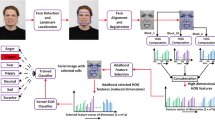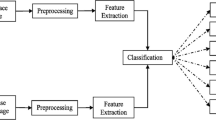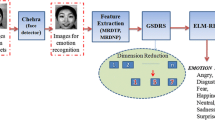Abstract
This paper develops a regularized discriminant analysis (RDA)-based boosting algorithm, and its application of the facial emotion recognition. The RDA-based boosting algorithm uses RDA as a learning rule in the boosting algorithm. The RDA combines strengths of linear discriminant analysis (LDA) and quadratic discriminant analysis (QDA). It solves small sample size and ill-posed problems suffered from QDA and LDA through a regularization technique. Additionally, this study uses a particle swarm optimization algorithm to estimate optimal parameters in RDA. In this work, the proposed RDA-based boosting is used in the facial emotion recognition, and achieves a good performance. In the facial emotion recognition, contourlet features are extracted and followed by an entropy criterion to select the informative contourlet features which is a subset of informative and non-redundant contourlet features. Experiment results demonstrate that the proposed RDA-based boosting can accurately and robustly recognize facial emotions.





Similar content being viewed by others
References
Chang CY, Huang YC (2010) Personalized facial expression recognition in indoor environments. In: Proc IEEE World Congress on Computational Intelligence, Barcelona, 2010, pp 3277–3284
Ekman P, Friesen WV (1978) The facial action coding system: a technique for the measurement of facial movement. Consulting Psychologists Press, Francisco
Fasel B, Luettin J (2003) Automatic facial expression analysis: a survey. Pattern Recogn 36(1):259–275
Feng X, Pietikäinen M, Hadid A (2007) Facial expression recognition based on local binary patterns. Pattern Recognit Image Anal 17(4):592–598
Friedman JH (1989) Regularized discriminant analysis. J Am Stat Assoc 84(405):165–175
Hoerl A, Kennard R (1970) Ridge regression: biased estimation for non-orthogonal problems. Technometrics 12(3):55–67
Kennedy J, Eberhart R (1995) Particle swarm optimization. In: Proc IEEE Int Conf Neural Networks, 1995, 4:1942–1948
Mehrabian A (1968) Communication without words. In: Psychology today, 2(4):53–56
Minh ND, Vetterli M (2005) The contourlet transform: an efficient directional multiresolution image representation. IEEE Trans Image Process 14(12):2091–2106
Pantic M, Rothkrantz LJM (2000) Automatic analysis of facial expressions: the state of the art. IEEE Trans Pattern Anal Mach Intell 22(12):1424–1445
Qi XX, Jiang W (2007) Application of wavelet energy feature in facial expression recognition. In: Proc IEEE international Workshop on Anti-counterfeiting, Security, Identification, 2007, ASID 2007, pp 169–174
Samal A, Iyengar PA (1992) Automatic recognition and analysis of human faces and facial expressions: a survey. Pattern Recogn 25(1):65–77
Shin FY, Chuang CF, Wang PSP (2008) Performance comparisons of facial expression recognition in JAFFE database. Int J Pattern Recognit Artif Intell 22(3):445–459
Yu H, Yang J (2001) A direct LDA algorithm for high-dimensional data- with application to face recognition. Pattern Recogn 34(10):2067–2070
Zhao L, Zhuang G, Xu X (2008) Facial expression recognition based on PCA and NMF. In: Proc of the World Congress on Inteligent Control and Automation art, 2008, pp 6822–6825
Zhi R, Ruan Q (2008) Facial expression recognition based on two-dimensional discriminant locality preserving projections. Neurocomputing 71:1730–1734
Acknowledgments
We would like to thank the National Science Council (Grant number: NSC 97-2221-E-155-064) for supporting this work.
Author information
Authors and Affiliations
Corresponding author
Rights and permissions
About this article
Cite this article
Lee, CC., Shih, CY., Lai, WP. et al. An improved boosting algorithm and its application to facial emotion recognition. J Ambient Intell Human Comput 3, 11–17 (2012). https://doi.org/10.1007/s12652-011-0085-8
Received:
Accepted:
Published:
Issue Date:
DOI: https://doi.org/10.1007/s12652-011-0085-8




